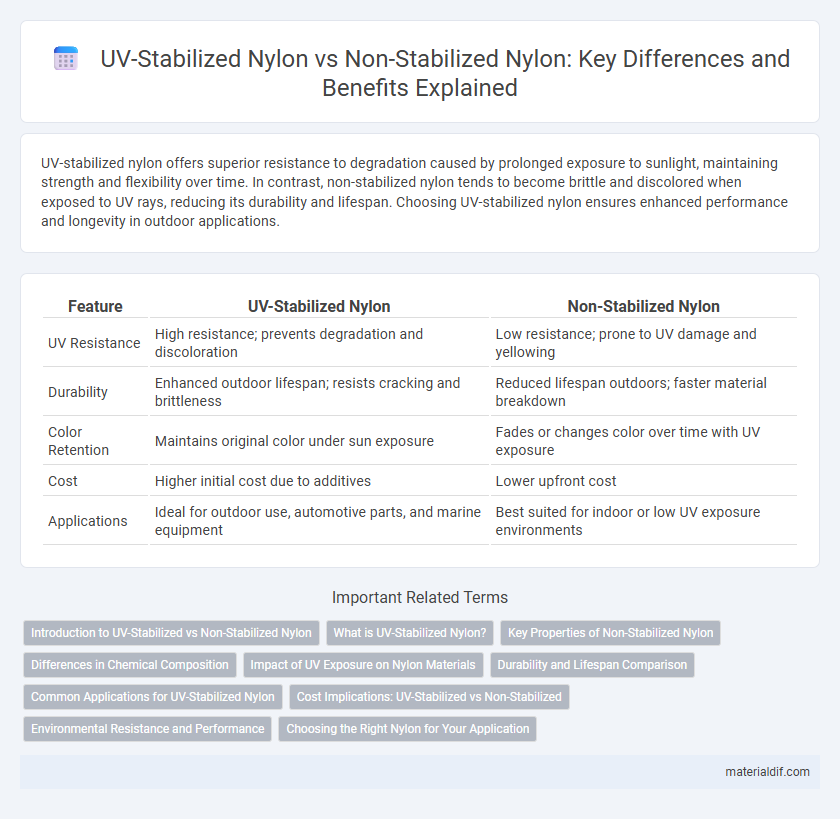UV-stabilized nylon offers superior resistance to degradation caused by prolonged exposure to sunlight, maintaining strength and flexibility over time. In contrast, non-stabilized nylon tends to become brittle and discolored when exposed to UV rays, reducing its durability and lifespan. Choosing UV-stabilized nylon ensures enhanced performance and longevity in outdoor applications.
Table of Comparison
| Feature | UV-Stabilized Nylon | Non-Stabilized Nylon |
|---|---|---|
| UV Resistance | High resistance; prevents degradation and discoloration | Low resistance; prone to UV damage and yellowing |
| Durability | Enhanced outdoor lifespan; resists cracking and brittleness | Reduced lifespan outdoors; faster material breakdown |
| Color Retention | Maintains original color under sun exposure | Fades or changes color over time with UV exposure |
| Cost | Higher initial cost due to additives | Lower upfront cost |
| Applications | Ideal for outdoor use, automotive parts, and marine equipment | Best suited for indoor or low UV exposure environments |
Introduction to UV-Stabilized vs Non-Stabilized Nylon
UV-stabilized nylon incorporates additives that protect polymer chains from degradation caused by ultraviolet radiation, significantly enhancing its durability in outdoor applications. Non-stabilized nylon lacks these UV inhibitors, making it more susceptible to brittleness, discoloration, and mechanical failure when exposed to prolonged sunlight. Selecting UV-stabilized nylon ensures improved longevity and performance in environments with high UV exposure.
What is UV-Stabilized Nylon?
UV-stabilized nylon is engineered with additives that protect the polymer chains from degradation caused by ultraviolet (UV) radiation, enhancing its durability and lifespan when exposed to sunlight. This modification prevents color fading, loss of mechanical strength, and surface cracking commonly seen in non-stabilized nylon under prolonged UV exposure. Applications requiring outdoor use, such as automotive parts and outdoor equipment, benefit significantly from the improved resistance of UV-stabilized nylon.
Key Properties of Non-Stabilized Nylon
Non-stabilized nylon typically exhibits high tensile strength and excellent abrasion resistance but lacks inherent UV resistance, making it prone to degradation and yellowing when exposed to prolonged sunlight. Its moisture absorption rate can affect dimensional stability and mechanical properties over time. Due to limited UV protection, non-stabilized nylon is best suited for indoor applications or environments with minimal direct UV exposure.
Differences in Chemical Composition
UV-stabilized nylon incorporates specific additives such as UV absorbers and hindered amine light stabilizers (HALS) to enhance resistance to ultraviolet radiation, preventing molecular chain degradation. Non-stabilized nylon lacks these additives, making its polymer chains more susceptible to photodegradation, resulting in brittleness and discoloration when exposed to sunlight. The chemical composition difference primarily revolves around the inclusion of these stabilizing compounds, which significantly influence the material's durability and lifespan under UV exposure.
Impact of UV Exposure on Nylon Materials
UV-stabilized nylon incorporates additives that significantly reduce degradation caused by ultraviolet radiation, preserving mechanical strength and color integrity over prolonged sun exposure. Non-stabilized nylon suffers from polymer chain scission under UV light, leading to brittleness, surface cracking, and loss of flexibility. This contrast makes UV-stabilized nylon essential for outdoor applications like automotive components and marine equipment where durability is critical.
Durability and Lifespan Comparison
UV-stabilized nylon offers significantly enhanced durability and a longer lifespan compared to non-stabilized nylon due to its resistance to ultraviolet radiation, which prevents degradation and brittleness caused by prolonged sun exposure. Non-stabilized nylon tends to weaken, discolor, and lose mechanical strength faster when subjected to UV rays, leading to premature failure in outdoor applications. This makes UV-stabilized nylon the preferred choice for products requiring sustained performance in harsh UV environments.
Common Applications for UV-Stabilized Nylon
UV-stabilized nylon is widely used in outdoor applications such as automotive parts, electrical connectors, and sporting goods due to its enhanced resistance to UV radiation, which prevents degradation and maintains mechanical strength. Common industries utilizing UV-stabilized nylon include construction, aerospace, and marine sectors, where exposure to sunlight can cause brittleness and color fading in non-stabilized variants. This makes UV-stabilized nylon ideal for durable, weather-resistant components like cable ties, housings, and exterior vehicle panels.
Cost Implications: UV-Stabilized vs Non-Stabilized
UV-stabilized nylon generally incurs higher upfront costs due to specialized additives that enhance resistance to ultraviolet degradation, extending the material's lifespan in outdoor applications. Non-stabilized nylon offers lower initial expenses but often requires more frequent replacement or maintenance, leading to increased long-term costs in UV-exposed environments. Evaluating the total cost of ownership reveals that UV-stabilized nylon provides better value where durability against sun exposure is critical.
Environmental Resistance and Performance
UV-stabilized nylon offers superior environmental resistance, maintaining mechanical strength and color integrity under prolonged exposure to ultraviolet radiation compared to non-stabilized nylon, which tends to degrade, discolor, and become brittle when exposed to sunlight. This enhanced durability makes UV-stabilized nylon ideal for outdoor applications such as automotive components, outdoor gear, and electrical insulation. Non-stabilized nylon performs well in controlled indoor environments but lacks the long-term weathering resistance necessary for sustained outdoor use.
Choosing the Right Nylon for Your Application
UV-stabilized nylon offers enhanced resistance to ultraviolet radiation, making it ideal for outdoor applications exposed to sunlight, such as automotive components and outdoor furniture. Non-stabilized nylon is suitable for indoor or low-UV environments where cost efficiency is prioritized over long-term UV durability. Selecting the right nylon depends on the exposure conditions and performance requirements to ensure material longevity and structural integrity.
UV-Stabilized Nylon vs Non-Stabilized Nylon Infographic

 materialdif.com
materialdif.com